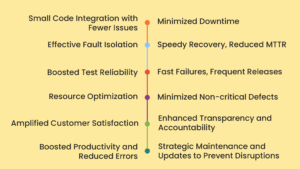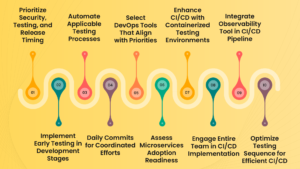
Software development is a fast-paced and dynamic industry, where the speed and efficacy of development processes often define the success of a project. One of the ways efficient software development teams achieve this is by using CI/CD, or Continuous Integration and Continuous Deployment within the framework of DevOps.
Here’s an informative read that delves into the nuances of CI/CD, its role in the software development process, and some industry best practices.
Table of Contents
An introduction to CI/CD concepts
While CI and CD are often used interchangeably, they are actually completely different concepts that work well in tandem. Here’s a brief introduction to CI/CD concepts.
What is CI (Continuous Integration)?
Continuous Integration is a development practice that encourages developers to integrate code into a shared repository frequently, preferably several times a day. With each integration, automated tests are run to detect and address issues early.
This practice reduces the chances of integration problems surfacing later in the development cycle, enabling teams to deliver reliable software at a faster pace.
What is CD (Continuous Delivery and Continuous Deployment)?
Continuous Delivery ensures that code changes are automatically prepared for deployment to production. It involves a series of automated tests and validation steps to ensure the code is production-ready.
Continuous Deployment, on the other hand, takes the process a step further by automatically deploying the code to production after passing the necessary tests in the delivery pipeline.
What is the Difference Between CI and CD?
While CI focuses on automating the process of integrating code changes into a shared repository and running tests, CD encompasses the automation of the entire delivery process, including the deployment of code changes to production environments.
In essence, CI sets the foundation for CD by ensuring that the code is always in a deployable state.
What is a CI/CD Pipeline?
A CI/CD pipeline is a series of automated steps that code changes go through, from integration and testing to deployment.
It ensures a streamlined and consistent process, minimizing manual intervention and reducing the risk of errors. The pipeline typically includes stages like building, testing, deploying, and monitoring.
Benefits of CI/CD Across the Industry

The multifaceted benefits of CI/CD in software development extend beyond rapid deployment. From enhancing software quality to minimizing downtime and boosting customer satisfaction, CI/CD practices empower organizations to embrace innovation while maintaining the highest standards of reliability and patient care.
Here’s a closer look at the benefits of implementing CI/CD in DevOps.
Small-Code Integration with Fewer Issues
One of the most profound advantages of implementing CI/CD in software development is its ability to facilitate small code integration with a notable reduction in issues. Through the continuous integration process, code changes are frequently merged into a shared repository.
These frequent integrations are complemented by automated tests that meticulously scrutinize the codebase for defects, inconsistencies, and potential bugs. This proactive approach to testing not only detects issues early but also ensures that they are isolated to smaller portions of the codebase.
As a result, when issues do arise, they are confined to a limited scope, making them significantly easier to identify, comprehend, and rectify.
Minimized Downtime
Software systems demand a high level of reliability and minimal downtime. CI/CD practices align perfectly with this requirement by allowing teams to deploy smaller code changes more frequently.
Unlike traditional monolithic updates that can cause substantial downtime during deployment, the iterative nature of CI/CD enables the deployment of incremental changes. This significantly reduces the potential impact of issues and the associated downtime.
Instead of large-scale updates that disrupt operations, softwares can undergo seamless and rapid updates, ensuring continuous availability and minimizing disruptions to critical services.
Effective Fault Isolation
In the realm of custom software, pinpointing the root cause of an issue is paramount. CI/CD aids in effective fault isolation by breaking down software changes into smaller units. When an issue surfaces, the granularity of these changes simplifies the process of identifying the source of the problem.
Developers can swiftly trace the issue back to a specific code change, making the debugging and resolution process far more efficient. This focused approach not only expedites the resolution but also enhances the overall stability of the software by preventing cascading failures.
Speedy Recovery, Reduced MTTR
Failures are an inevitable aspect of software development, but CI/CD equips software development teams with the tools to respond swiftly and efficiently. Automated processes within the CI/CD pipeline facilitate rapid recovery in the event of failures.
The automated testing and deployment procedures streamline the process of rolling back to a stable state, reducing the Mean Time To Recovery (MTTR). As a result, the impact of failures is minimized, and critical healthcare services can be restored promptly, ensuring patient safety and the continuity of care.
Boosted Test Reliability
Automated testing lies at the core of the CI/CD philosophy. Each code change triggers a battery of automated tests that assess various aspects of the software’s functionality, performance, and security.
The consistent and thorough nature of these tests enhances the reliability of the software. By subjecting every change to a comprehensive suite of tests, CI/CD ensures that no aspect of the software’s integrity is compromised. This not only results in a robust product but also instills confidence in the development team, quality assurance, and end-users alike.
Fast Failures, Frequent Releases
The philosophy of “fail fast” is a guiding principle in software development, especially in healthcare. CI/CD embraces this philosophy by rapidly detecting failures and shortcomings early in the development process.
Failures are identified and addressed in the nascent stages, preventing their propagation through subsequent iterations. This iterative approach encourages more frequent releases of software updates, each incorporating fixes, improvements, and new features.
The result is a software ecosystem that evolves quickly, adapts to changing requirements, and maintains a high level of performance and reliability.
Resource Optimization
Traditional software development practices often consume substantial developer time and computing resources. CI/CD, with its emphasis on automation, effectively optimizes these resources.
Automated testing, building, and deployment processes eliminate the need for manual interventions and the associated time investment. Developers can focus their energy on innovation, problem-solving, and addressing critical issues rather than repetitive and time-consuming tasks.
This resource optimization accelerates the development cycle and empowers teams to deliver high-quality software efficiently.
Minimized Non-critical Defects
In software development, especially in areas like custom healthcare software development, even minor defects can have far-reaching consequences. CI/CD’s commitment to continuous testing and integration combats the accumulation of non-critical defects.
By systematically subjecting each code change to a battery of automated tests, the pipeline identifies and rectifies issues, regardless of their severity.
This rigorous testing approach ensures that the software is always in a dependable state, fostering confidence in its performance and minimizing the potential for non-critical defects to escalate into significant problems.
Amplified Customer Satisfaction
The software industry places a premium on reliability, performance, and user satisfaction. CI/CD’s contributions to bug fixes, feature releases, and overall software stability have a direct impact on customer satisfaction.
Swift resolutions of issues, coupled with frequent feature updates, provide users with a responsive and continually improving software experience. Additionally, the enhanced stability achieved through CI/CD practices instills trust in the software’s capabilities, translating to improved user engagement and loyalty.
Enhanced Transparency and Accountability
The automated nature of the CI/CD pipeline introduces a level of transparency into the development process that is instrumental in fostering accountability. The entire development lifecycle, from code integration to deployment, is documented and traceable.
This transparency encourages a culture of accountability among team members, as every change is linked to a developer, a test result, and a deployment status. This heightened
Accountability ensures that issues are addressed promptly, quality is upheld, and the software’s reliability is maintained.
Boosted Productivity and Reduced Errors
CI/CD’s extensive automation significantly boosts the productivity of software development teams. Automation eliminates manual errors, reduces the time spent on repetitive tasks, and accelerates the overall development cycle.
Developers can focus on creative problem-solving and innovation rather than being burdened by manual tasks such as code integration and deployment. The reduction of manual intervention also decreases the likelihood of human errors that can lead to defects and vulnerabilities in the software.
Strategic Maintenance and Updates to Prevent Disruptions
Regular maintenance and updates are essential in healthcare software to ensure security, performance, and compliance. CI/CD’s incremental approach to updates makes maintenance activities far more manageable.
By consistently delivering smaller, well-tested changes, software teams can avoid large-scale, disruptive updates. This strategic approach minimizes the risk of service interruptions, provides a more seamless experience for end-users, and supports the smooth functioning of critical healthcare systems.
CI/CD Best Practices

If you’re looking at implementing CI/CD into your DevOps process, here are some industry best practices for you to consider.
Prioritize Security, Testing, and Release Timing
Incorporating security measures right from the outset is paramount in software development. Begin by integrating security protocols into the CI/CD pipeline, ensuring that vulnerabilities are addressed as soon as they are identified.
Comprehensive testing should be at the core of your CI/CD strategy. Adopt a testing framework that spans unit, integration, performance, and security tests, leaving no stone unturned in identifying potential issues.
Additionally, time your releases strategically to avoid conflicts with critical periods in daily operations, minimizing the risk of disruptions.
Implement Early Testing in Development Stages
Early detection of issues is a hallmark of successful CI/CD implementation. Embed testing into the development process right from the outset. As code changes are introduced, automated tests should immediately scrutinize them for bugs, regressions, and other defects.
This practice ensures that issues are caught and addressed at their inception, preventing their escalation into more complex problems later in the development cycle. The sooner issues are identified, the more cost-effective and efficient their resolution becomes.
Automate Applicable Testing Processes
Automation is the cornerstone of effective CI/CD. Embrace automation for testing processes, ranging from unit tests to complex integration and regression tests. Automated testing not only expedites the development cycle but also ensures consistency in testing outcomes.
By automating these processes, you reduce the potential for human error and guarantee that every code change undergoes a standardized battery of tests before deployment, safeguarding the integrity of the software.
Daily Commits for Coordinated Efforts
Encourage a culture of continuous integration by promoting daily code commits. Regular commits not only keep the codebase up-to-date but also enable a steady flow of integration.
This practice enhances collaboration among team members, as it reduces the likelihood of integration conflicts arising from prolonged isolation of code changes. Frequent integration also aids in the early detection of issues, making them easier to address.
Select DevOps Tools That Align with Priorities
The DevOps landscape is replete with tools catering to various needs. However, the key is to select tools that align with your team’s priorities and the project’s goals.
Evaluate the features, integrations, and learning curves of different tools to ensure they complement your workflow seamlessly. Tools that facilitate collaboration, automate processes, and provide visibility into the CI/CD pipeline’s performance are particularly valuable.
Assess Microservices Adoption Readiness
Microservices architecture can offer significant benefits in terms of scalability, modularity, and maintainability. However, it requires careful consideration before adoption. Evaluate your project’s readiness for microservices by assessing factors such as team expertise, infrastructure capabilities, and the complexity of your application.
While microservices can enhance CI/CD practices, a solid foundation and a well-considered strategy are essential for successful implementation.
Enhance CI/CD with Containerized Testing Environments
Containerization, often through technologies like Docker, has revolutionized software deployment and testing. Leverage containerization to create consistent testing environments that mirror production setups.
This ensures that tests are conducted in an environment that closely resembles the real-world conditions, minimizing the chances of deployment issues arising due to environmental disparities. Containerized testing environments streamline testing processes and enhance the reliability of the pipeline.
Engage Entire Team in CI/CD Implementation
CI/CD implementation is a collaborative effort that spans developers, testers, operations, and beyond. Engage the entire team in the process to foster a sense of ownership and shared responsibility.
Encourage open communication and knowledge sharing to bridge gaps between different roles. This holistic approach not only ensures that every perspective is considered but also strengthens the overall effectiveness of CI/CD practices.
Integrate Observability Tool in CI/CD Pipeline
The ability to monitor and gain insights into the CI/CD pipeline’s performance is crucial for continuous improvement. Integrate observability tools that provide real-time visibility into the pipeline’s stages, bottlenecks, and issues.
These tools enable you to identify areas for optimization, detect anomalies early, and make data-driven decisions for enhancing the pipeline’s efficiency and reliability.
Optimize Testing Sequence for Efficient CI/CD
The sequence in which tests are executed can significantly impact the efficiency of the CI/CD pipeline. Prioritize tests based on their speed, significance, and ability to catch critical issues.
Fast-running tests, such as unit tests, should be positioned at the beginning to provide rapid feedback to developers. As the pipeline progresses, incorporate more time-consuming tests to ensure a balanced approach that maintains both speed and effectiveness.
Leverage Our CI/CD Expertise to Build Your Custom Software
CrossAsyst custom software teams recognize when our clients need CI/CD to be implemented in order for their custom software builds to yield the optimal results. Here is a short case-study to illustrate the point.
The client
The client is a leading American provider of tele-emergent medical care services.
Challenges
- The customer had never practiced DevOps or utilized a framework. Hence, we needed to implement DevOps practices, such as building and deploying software packages, to deliver high velocity code. Additionally, we aimed to gain real-time insights into application health and infrastructure health.
- Testing software changes was critical to improve the chances of the client’s code functioning optimally upon release to all users. However, the customer lacked efficient testing processes and was unable to maintain test environments.
Solutions provided
- As part of the solution, we implemented CI/CD using Jenkins and Ansible for automation, employing the Blue-Green Deployment strategy to achieve zero downtime during production releases on EC2 Servers.
- We established and enabled a monitoring mechanism using the open-source tool called Icinga. We integrated OpsGenie to provide alerts through email, SMS, and phone calls.
This approach allowed us to maintain continuous monitoring 24/7/365, leading to a reduction of frequent production incidents by nearly 95% through a proactive approach.
- We addressed the client’s software testing needs by creating distinct test environments for developers to test their code. These environments were categorized into two groups: Lower and Upper.
The Lower environment covered development, QA and related areas, while the Upper environment included staging, demos and production.
We utilized Terraform modules through the Infrastructure as Code (IaC) methodology to build and manage these environments effectively.
Why CrossAsyst Ought to be Your Custom Software Partner
We at CrossAsyst have been helping our clients give wings to their custom software dreams for well over a decade. With extensive experience in healthcare software development, our HIPAA compliant software development teams have experience that goes beyond DevOps expertise.
Be it gaining an in-depth understanding of your unique custom software needs, to ensuring the quality of the end product is beyond reproach, thanks to rigorous testing, mock-ups, demos and more, you can be assured of CrossAsyst’s commitment to your success.
Book a meeting with CrossAsyst today, and let us help you build software that will power your business well into the future.




